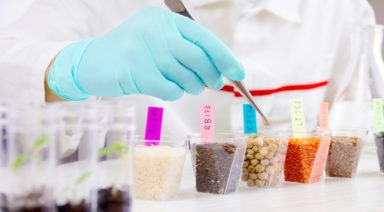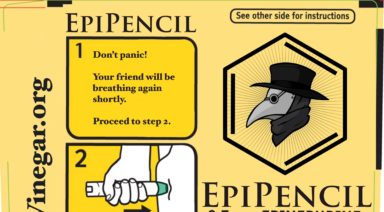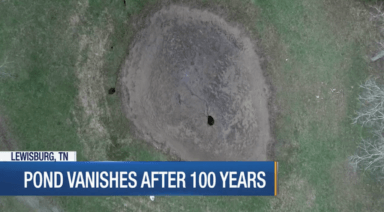Mites, Monsanto Cause Colony Collapse Disorder; Is Fungi A Solution?
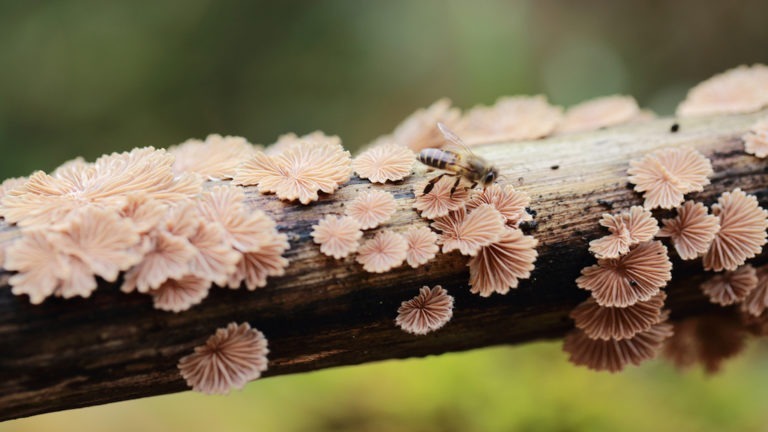
Something has killed honey bees in droves for the past 20 years leading to what’s known as colony collapse disorder. For a while, the culprit remained ambiguous, but now scientists are discovering that a number of anthropogenic factors, including Monsanto’s herbicide glyphosate, pesticides, and parasites may be to blame. Though these may seem like disparate problems requiring complicated solutions, there is one man who believes he has an answer that could save the bees—that man is Paul Stamets, and his answer is fungi.
Over the past several years, Stamets has become something of a rockstar in the field of mycology—the study of fungi—for his radical and pioneering work discovering the endless applications and influences mushrooms have on our world.
Since he began researching fungi in the 1970s, Stamets has received 12 patents, written six books, and been recognized by a multitude of esteemed institutions. There’s even a character on Star Trek: Discovery named after him—Lt. Cmdr. Paul Stamets.
Part of Stamets’ appeal stems from his Deadhead-turned-scientist persona that views fungi from a spiritual perspective, not just a materialist lens. Stamets admits his early use of Psilocybe cubensis, also known as “magic” mushrooms, became the catalyst for his fascination, leading to a lifelong journey studying the myriad mycelia that populate the planet.
Stamets’ discoveries have changed lives and now he hopes to parlay his mushroom knowledge into a comprehensive plan to save the bees, and in the process, maybe save humanity as well.
Colony Collapse Disorder
Colony collapse disorder is the phenomenon in which there is a mass exodus of worker bees from the hive, typically dying or fleeing from infection. These bees leave their queen behind with a few nurse bees to care for her, though their chances for survival drop significantly, especially as winter draws near. Scientists have identified several factors related to colony collapse, most of which stem from pathogens and chemicals that degrade bees’ immune systems.
And while we all know bees produce honey and wax, many don’t realize just how crucial they are to our survival as a species.
Bees are pollinators, and while this may seem obvious, many are unaware of just how essential bee pollination is to agriculture. When a bee collects nectar from a plant it picks up pollen and transmits it to other plants, allowing them to bear fruit. And a single bee can pollinate up to 1000 flowers a day.
This process is necessary for our agricultural industry, as about 35 percent of our food is directly dependent on bee pollination, while the other 65 percent is indirectly dependent. If bee pollination suddenly ceased, it’s estimated around $16 billion worth of crops would be affected in the United States alone.
And over the past few decades, beekeepers and entomologists have noticed massive drop-offs in bee populations globally. In a matter of a single year, states like Oklahoma lost as much as 85 percent of beehives due to colony collapse. According to the U.S. Dept. of Agriculture, a third of all bee colonies have died each year since 2006. So, what exactly is causing this apiological pandemic?
Colony Collapse Disorder Causes
While there isn’t one answer, there are a number of factors contributing to the current bee-reavement of our buzzing friends. One of the most common issues is a parasite called the Varroa mite. Also known as the Varroa destructor, this external parasite is known to invade and attack Apis mellifera and Apis cerana—the western and eastern honey bee.
These nasty parasites look like a small reddish-brown or white button latched to a honey bee’s back. Spawning in 10-day cycles, the mites lay eggs on larvae, often infecting bees before they finish pupation. When this happens, new worker bees are compromised before they hatch, entering the world with viruses or genetic defects, such as wing deformities. Once exposed to these mites, a hive typically collapses after only a seven percent infestation.
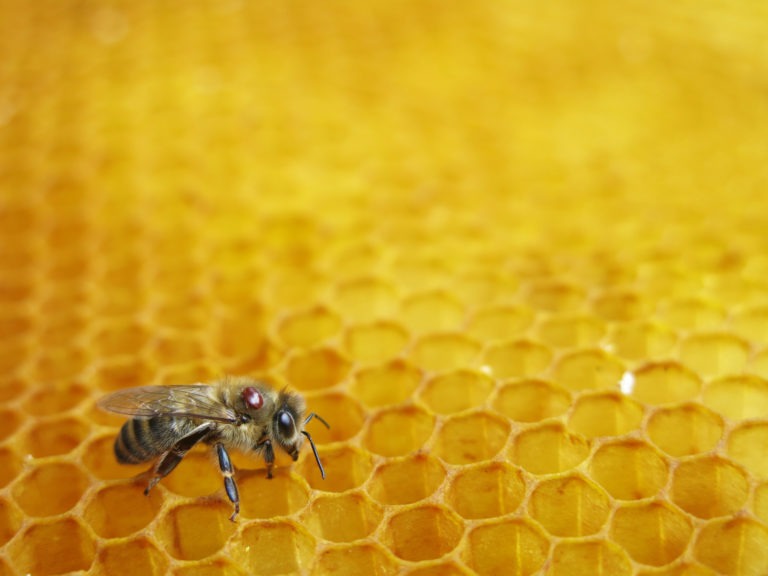
Honey bee infected by a Varroa mite
“The Varroa destructor mites are something all beekeepers will eventually face,” Craig Patterson, Gaia employee and in-house beekeeper said. “Currently, I’m experimenting with Russian genetics, which is expected to be resilient to the parasite and highly-tolerable to our cold climate in Colorado.”
Every year Patterson said he has to take measures to fend off Varroa, and sometimes it’s just a matter of the bee’s genetic type. But this has become less effective as the mites adapt.
“The two main genetic types of honey bees – Italian and Carniolan — have been used for years, but unfortunately they’re becoming less resilient,” Patterson said. “And you can use non-natural treatments, but they weaken the bees and the hive, and you usually have to do it right before winter, which doesn’t really set them up for success, especially for the hard months in a cold climate like Colorado.”
And as much as they’d prefer not to, using those potent chemical sprays has been the last line of defense most beekeepers have to fight the mite. That was until Stamets claimed he found the fungal solution.
Exposing honeybees to a type of fungal spore known as Metarhizium anisopliae has proven itself promising in the war on Varroa. Metarhizium is a strain of fungi known as an entomopathogen, or parasitoid, meaning it’s parasitic to parasites themselves. Some may be familiar with similar types of parasitic fungi like Ophiocordyceps, which infects insects — ants particularly — turning them into mind-controlled zombies, before killing them and growing a spore from their head to infect others. Nature can be ruthless…
Though bees are susceptible to the effects of Metarhizium, they groom themselves as methodically as cats, wiping away the fungal spores. Stamets is working in conjunction with beekeepers at Washington State University, one of the foremost institutes in apiology, to create Metarhizium-based fungal products to fight Varroa mites. He says a product should be available to beekeepers sometime this year.
Colony Collapse Disorder from Pesticides
There have been a number of studies testing whether Monsanto’s glyphosate-based herbicide RoundUp, may be playing a role in colony collapse disorder, and it was recently determined that it appears so.
A study conducted by researchers at the University of Texas found bees exposed to glyphosate had a significant decrease in four of eight types of healthy bacteria found in their gut microbiome, notably one called Snodgrasella alvi.
Just like we humans have become concerned with the diversity of our gut microbiota, the health of bees’ microbiome is essential to their livelihood. Snodgrassella alvi is crucial to bees’ digestive process as well as their ability to fight off pathogens.
After observing this, researchers exposed bees to typical pathogens they would face in the field, noticing those exposed to glyphosate died at a significantly higher rate. Of course, Bayer/Monsanto refuted the validity of the experiment saying the study didn’t sufficiently mimic field conditions. But that’s unsurprising considering the company rejected negative results from a self-sponsored study in which scientists tested the effect of pesticides known as neonicotinoids (neonics) on colony collapse disorder – a year later a larger study affirmed those results.
Just like it sounds, neonics are insecticides resembling nicotine that have been eyed as a potential culprit that’s causing colony collapse. According to the aforementioned study, it turns out the local environment has a lot to do with the way neonics affect bee colonies. In areas of great forage diversity – where there are more wildflowers and types of pollen available – the neonics had no immediate negative effect on the colony. However, in areas where there was primarily commercial farming and less variety of wildflowers, bees were significantly affected, particularly when it came to reproduction.
The study’s authors concluded that in areas where bees are highly dependent on pesticide-treated crops and weakened by disease, they were more susceptible to the negative effects of neonics. But during winter, bees in both areas were more susceptible to colony collapse due to the effects of neonics. The study’s author called it a “cause for concern.”
And Patterson said he’s aware of this too, especially with bees pollinating monoculture crops, like RoundUp-ready corn.
“I haven’t necessarily had direct experience, but I know one of my home hives got into something chemical-based,” he said. ” I saw a lot of die-off in weird, sporadic ways; bees flopping around on the ground, crawling around, acting strange, essentially exhibiting abnormal motor skills. Investigating further, I noticed some of the bees died with their tongues sticking out, which can be related to herbicide or pesticide poisoning.”
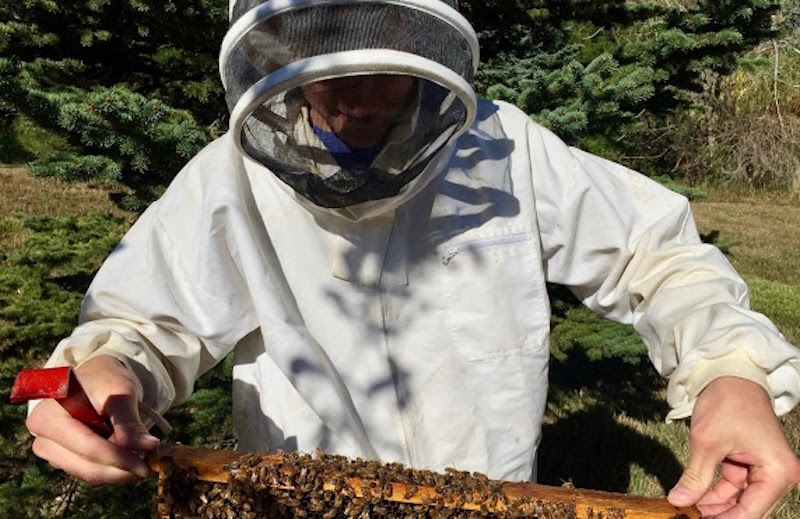
Gaia beekeeper and engineering wizard, Craig Patterson
The study also found neonic residues dissolved into groundwater and were taken up by wild plants in the area. This was found coming from a test of bees that collected 99 percent of their nectar from wildflowers. In light of the study, EU regulators imposed a partial moratorium on neonics.
So, what’s Stamets’ solution this time?
At his home in Washington, Stamets one day noticed a swarm of honey bees sipping something from mycelia growing in a patch of wood chips near his garden.
“I looked down, and they were sucking on my mycelium,” he said.
Stamets connected the dots, realizing he previously learned Reishi and Amadou mushrooms growing from rotting wood were good for human immune systems in treating certain pathogens, such as tuberculosis, smallpox, and bird flu.
Seeing their attraction to them, he figured they must be good for bees’ immune systems as well. So, he pitched his idea to researchers at Washington State University. They were so excited about the prospect, they pleaded him not to work with anyone else. And for the past few years, Stamets has worked with WSU entomologist Walter S. Sheppard feeding sick bees an extract made from these particular mushroom mycelia.
Their results have shown promise in reducing viruses and increasing the bee lifespan. In their trials, they found that colonies fed these mushrooms extracts saw a 79-fold reduction in deformed wing virus – a condition caused by Varroa – and a 45,000-fold (yes, you read that correctly) reduction in another genetic issue called Lake Sinai Virus, compared with control colonies.
Stamets and his colleagues hope to have several products available for beekeepers soon to mitigate the massive losses their industry has sustained and hopefully save bee populations around the world. For the sake of the bees and our future livelihood as a species, let’s hope it works.
For more fascinating fungal insight, watch this episode of Inspirations with master mycologist Paul Stamets:
Popular Cereal, Granola Found to Contain Unsafe Levels of RoundUp

You might want to think twice before pouring yourself a bowl of your favorite cereal or granola, as Monsanto’s likely-carcinogenic products have probably contaminated your breakfast. Glyphosate, the active ingredient in the herbicide RoundUp has been found at unsafe levels in popular cereals such as Lucky Charms, Cheerios and Nature Valley granola, according to a recent study.
The study was published by the Environmental Working Group (EWG) – a philanthropic research group dedicated to studying the effects of toxic chemicals on children’s environmental safety. The group set a benchmark for safe levels of glyphosate in food products at 160 parts per billion (ppb), to test 45 conventional products and 16 organic products. Of those, 43 conventional products tested positive for glyphosate, while 5 organic products tested positive, though none of the organic products exceeded EWG’s safety benchmark.
The conventional products that tested high included Lucky Charms around 315 ppb; Quaker Dinosaur Egg Instant Oatmeal between 700 ppb; Quaker’s Old-Fashioned Oats between averaged 930 ppb; Nature Valley Granola Bars around 340 ppb; and Cheerios Whole Grain Oat Cereal averaged 497 ppb.
For a full list of the snacks and cereals tested for glyphosate look here.
EWG’s study was sparked by a recent lawsuit, which awarded $289 million to a man dying of cancer linked to his use of Monsanto’s RoundUp. Hopefully, this latest development will finally bring about the awareness needed for glyphosate-based products to be banned from use or highly regulated.



